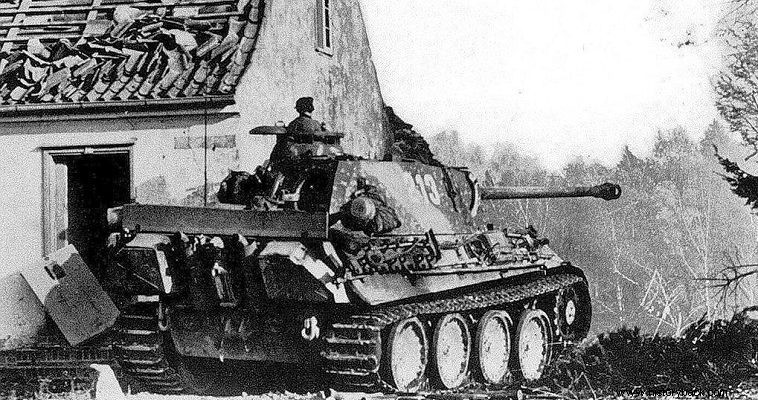
In January 1945, Soviet forces had split the German front in Poland on the Vistula River. The German armies were pushed back as far as the Oder River in the west. The German 2nd Army, on the other hand, retreated northwards and occupied defensive positions in Pomerania and West Prussia, on the shores of the Baltic.
The city of Danzig was the reason for the outbreak of World War II in 1939 . In 1945, however, the situation was to be reversed.
The 2nd Army took over the defense of the Baltic coast from the mouth of the Vistula river, east, to Gotenhafen (today's Gdynia), west, included in Army Group (OS) Vistula. The strongest divisions of the 2nd Army were the 4th and 7th Panzer Divisions (MPa) . Gradually, during February, the Soviet forces completely cut off the 2nd Army from the rest of the German forces and began to press it on its western flank.
Defense…
From the end of February until the first days of March, the 2nd Army's front had been reduced to 70 km. This resulted in each Soviet army operating on an attack front of 15 km.
The goal of the Soviets was to slowly limit the Germans to Gotenhaven and Danzig by constantly pushing from the west-southwest.
Marshal Rokosovsky decided to capture the small port of Chopot, between Danzig and Gothenburg, in order to break up the German enclave so that it would be easier to neutralize it On March 13, the Soviets began bombing Chopot (present-day Sopot, Poland) with the apparent aim of cutting the remaining enclave under the control of the German 2nd Army in half. At the same time, the Soviets began to exert pressure west of Danzig.
Departments of the 4th Army executed an immediate counterattack. However, the 4th BA was now a shadow of its former self. After the counterattack he was left with only four combat-ready Panther tanks and one assault gun. Under these conditions, a new Soviet attack succeeded. A new German counterattack resulted in the partial recapture of the lost positions.
The most dangerous Soviet penetration, however, was the one towards Tzopot. So the 4th Army was ordered to reinforce the half-dissolved German divisions that were trying to hold, literally with their teeth, their positions.
Two lone Panther tanks
"Late in the afternoon (of March 13) Lieutenant Gerlach arrived at the positions of the 389th Infantry Division (IP) with two Panther tanks. The two tanks were ordered to support a night attack by an infantry battalion. At 20.00 the riflemen of the 389th MP started.
"It was already dark. The attackers advanced despite heavy enemy fire. We could clearly hear the sound of tanks firing. In the meantime we realized that at least 24 enemy tanks, of which eight heavy Josef Stalin , was opposite us in New Belt (west of Chopot).
"And against the superiority of the enemy we only had two Panthers. When the riflemen of the 389th MP reached the village they destroyed an enemy tank and an anti-tank gun with a Panzerfaust, but came under heavy fire and retreated. At that moment Lieutenant Gerlach's Panther came to a standstill . Gerlach, however, along with his radio operator, Sergeant Kupfer, boarded the last Panther.
“The crew consisted of Gunnery Sergeant Lang, Loader Lance Corporal Heinrich and Driver Lance Corporal Bauer. The single Panther moved towards the village train station with the engine at low revs so that the noise produced is as small as possible.
"As a veteran of the punches, Gerlach knew well that only surprise would give him hopes of prevailing in such an unequal battle. The falling snow covered the chariot. A railroad car also covered it from enemy observation in the twilight…
“At some point the Soviets heard the sound of the engine and started firing blindly. Gunner Lang opened fire on the flare of the enemy guns and hit an enemy assault gun which burst into flames. Three more Soviet tankswere spotted in the light of the fire ", says a German soldier in his diary.
The unequal battle between the lone Panther and the infantry battalion continued on 16 March when a second tank arrived with crew chief Sergeant Palm, known as the "tank destroyer". Palm's tank destroyed two Soviet tanks, one of which was Josef Stalin, and disabled another tank of the same type. He also destroyed a number of Soviet anti-tank guns.
The day and the following night passed relatively calmly with the Soviets not daring to move. At dawn on March 17, they attempted an attack further north of the village. The two Panthers moved there and managed to repel the attack, destroying a Soviet infantry company, five Josef Stalins, another Soviet heavy tank, three assault guns and an anti-tank gun.
The next day, 18 March, Gerlach still held his ground, destroying another Stalin, three more Soviet tanks, two assault guns and two anti-tank guns . After a day and night of fighting and vigilance, when Gerlach was called to give a report, as soon as he sat down he immediately fell asleep leaning on a table! But he had accomplished a feat.
Nevertheless, the situation was tragic for the Germans. Their defense gradually collapsed.
